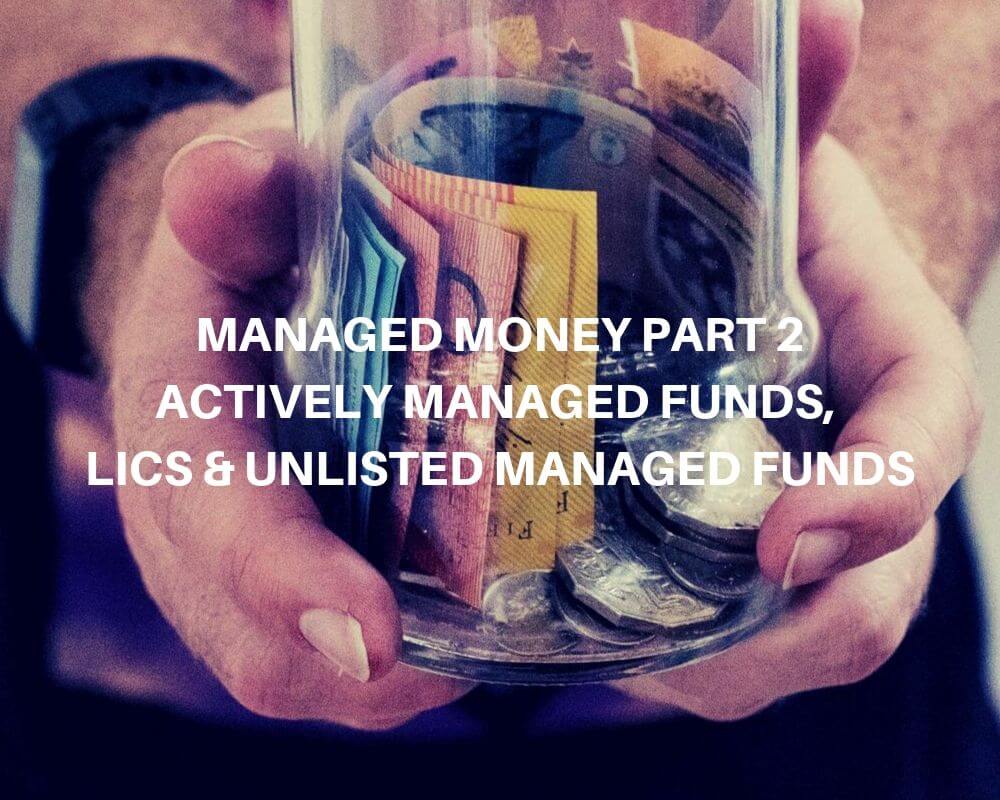
Listed Investment Companies and Unlisted Managed funds
This post follows the post on Passive funds- Index Funds and ETFs.
In this post we will discuss:
- Listed Investment Companies (LICS)
- Unlisted Managed Funds
- Some subtle differences between each
This page may contain affiliate links which might pay me a commission. I may also hold positions in the investments discussed. Please read my disclaimer for more info.
What is a Managed Fund?
A managed fund is a pool of money from investors that is looked after by a paid fund manager and management team.
Each fund has a philosophy that guides its management decisions. Themes include investing for dividends, growth, emerging markets or infrastructure.
The manager actively conducts research, quantifies risk and decides how to allocate the fund’s assets in a diversified portfolio.
Asset allocation is discretionary, unlike index investing where holdings are based on a predefined set of rules.
Funds compare themselves to a benchmark index that closely relates to the investment philosophy. For Australian funds, the ASX200 index (XJO) is commonly used. Funds that invest in small cap stocksmight choose the Small Ordinaries Index (XSO) as their benchmark. Read more about indexes in the previous post or here.
The benchmark index allows investors to assess the performance of their fund manager and is also used to calculate performance bonuses.
Managed funds charge investors a fee to cover the cost of research and administration. This is typically called the Management Expense Ratio (MER) where a fixed percentage of the funds invested are deducted to cover these costs. For
Investors may also be charged a spread, entry and exit fees and performance fees should the fund outperform the benchmark.
There are 2 main ways to invest in managed funds in Australia- Listed Investment Companies (LICs) and Unlisted Funds.
Listed Investment Companies (LICS)
What Is An LIC?
An LIC is a managed fund that exists as a public company, listed on the Australian Stock Exchange (ASX).
Its initial investment capital is raised through an initial public offering (IPO). The company publishes a prospectus that outlines is investing philosophy, expected returns and fee structure. Investors who believe in the potential success of the LIC deposit money in exchange for shares. The fund manager uses this money to purchase a portfolio of assets. The value of these assets is called the Net Asset Value (NAV) or Net Tangible Assets (NTA). Regarding LICs, ETFs and managed funds, the NAV and NTA are quite similar and used interchangeably.
The company is then listed on the ASX where its shares can be purchased and sold by members of the general public.
LICs are “closed ended” funds with a fixed number of “shares”. Investors do not inject further capital into the fund unless there is another capital raise where more shares are created. This is in contrast to index funds and Index ETFs which are “open ended”, where the number of units goes up when new funds are injected and decreases with redemptions.
LICs are actively managed and gives investors diversification. By having control of the capital, the fund manager does not need to be concerned about fund outflows.
At mid 2019, there are over 100 Australian LICs. The biggest LICs by market capitalisation are:
- Australian Foundation Investment Company (ticker code: AFI) $7.6 billion
- Argo Investments (ARG) $5.8 billion
- Milton Corporation (MLT) $3.2 billion
- Magellan Global Trust (MGG) 2.3 billion
- WAM Capital (WAM) $1.6 billion
How Do You Invest In An LIC?
LICs are given a ticker code and traded on the ASX. Shares in LICs are purchased using a stock broking service such as Commsec or Self Wealth. You can periodically increase your holdings or dollar cost average by purchasing more shares.
In theory you can purchase a single share in an LIC though most brokerage platforms have a minimum $500 purchase. Purchases of small amounts are likely to see your capital eaten up by brokerage fees.
How Are LICs Priced?
Like all shares in all listed companies, the price you pay is dependant on market supply and demand.
You can buy “at market” where your order will be filled immediately. The price you pay is the ask price- the price an existing shareholder is willing to accept. Conversely, you can place a limit order which states the maximum price you are willing to pay. The transaction takes place when an existing shareholder accepts your offer price.
Its important to understand that the price you pay for shares in a LIC is not directly related to the NAV. If a fund manager is doing particularly well, investors may want to get onboard and are happy to pay a premium. Conversely, if a fund performs poorly, investors may be willing to liquidate at a lower price. This means that LICs can trade at a “premium” or “discount” to the underlying assets of the company.
Let’s illustrate this with an example- say ABC LIC has 1 million shares and the NAV is $1 per share. Last year, ABC’s manager did amazingly well and significantly outperformed the ASX200. Investors expect ABC to do well again this year and want to get onboard for the ride. So despite the funds underlying assets being worth $1 per share, excited investors are willing to pay $1.05 per share. They are willing to pay a 5% “premium” on the value of the LICs underlying assets because they expect the following year’s gains to outweigh this price premium.
Conversely, if this year the ASX200 goes up 15% but ABC is unable to raise its per share NAV from $1, some investors may choose to sell their shares and put their money to better use elsewhere. They may be willing to sell their shares for $0.90 or a 10% “discount” to the NAV. Yup, that’s right, you can actually purchase a dollar of the fund’s assets for just 90 cents!
See which LICs are trading at a premium or discount at MorningStar.
What Are The Fees?
There are 2 main fees to look out for in the LICs product disclosure statement.
The first is the Management Fee. The LIC pays their team of managers to research investments and has costs for brokerage and administrative. These fees are bundled together and described as the Management Expense Ratio (MER). This is a percentage of the portfolio value. The MER of LICs is normally higher than ETFs and Index Funds.
Here is the current MER of the biggest five- AFIC 0.14%, Argo 0.15%, Milton 0.13%, Magellan Global Trust 1.35%, WAM 1.0%.
The second is the Performance Fee. If the management team outperforms the fund’s benchmark index they may attract an additional fee.
AFIC, Argo, Milton do not have performance fees while Magellan Global Trust’s is 10% and WAM Capital’s is 20%.
As LICs are traded on the ASX, there is brokerage associated with buying and selling the shares.
Income- What Dividends Do You Receive?
LICs typically pay shareholders a franked dividend twice a year. Some of the profits may be retained within the company to purchase additional assets.
A number of LICs offer Dividend Investment Plans (DRP) where instead of receiving a dividend, the funds will be used to purchase extra shares in the LIC. This enables you to compound your investment and avoids the cost of brokerage.
In addition to the DRP, AFIC offers shareholders a Dividend Substitution Share Plan (DSSP). Instead of receiving dividends and paying tax, investors can elect for the value of their dividend to purchase more AFIC shares. Tax is not payable on the dividend but is deferred to when the shares are sold – please check these details with your accountant. You can read about AFIC’s DSSP here.
Argo Investments had a similar Share Purchase Plan but this is not currently available.

Liquidity- Getting Your Money Out
LICs are sold via your stock broking service. Like with your purchase, you can sell it “at market” or set a “limit”- the lowest price you are willing to part with your shares. You can set your price at a premium, discount or at the NAV. Smaller LICs may have thin trading volumes and require you to discount your price if you’re after a quick sale.
See a list of LICs at Morningstar.
Unlisted Managed Funds
What Is An Unlisted Managed Fund?
As it’s name suggests, these are investment funds not listed on the Australia Stock Exchange.
An investment company like Vanguard, Magellan or Perpetual assigns a fund manager to actively research and invest money in a portfolio of assets.
The fund is actively managed and gives investors diversification. They are popular with individual investors and self managed super funds.
Funds have a philosophy to guide their investment strategy. These can include investing in global companies, ethical investments, emerging markets, resources, small cap stocks, infrastructure, real estate and bonds. There are also hedge funds that trade both the long and short sides of the market using derivatives to leverage their positions.
These funds typically measure themselves against a benchmark index which is also used to calculate performance fees.
Unlike LICs, unlisted funds may be “open ended” allowing the fund to take in new money from investors. This increases its asset base and the fund issues new units. Some managed funds are “closed ended” just like LICs.
There are over 2,000 unlisted managed funds in Australia. Canstar gave awards to Colonial, Macquarie Investment Management and OnePath in their 2019 Managed Fund awards.
Popular funds are also available from Platinum, Magellan and Perpetual.
How Do You Invest In An Unlisted Fund?
You purchase units in unlisted funds either directly with the fund company, through your stock broker or financial planner.
Because you are investing with the investment company, you will be required to complete their compliance paperwork.
This differs from LICs where you are buying or selling shares with other investors.
Minimum investment amounts are usually between $5,000 and $500,000.
The funds will also describe a minimum suggested timeframe for holding the assets. Commonly this is greater than 7-10 years. You can also view the recent returns of the fund on their website.
There is usually an option to add additional investments and subscribe to dividend reinvestment plans
What Are The Fees?
There are a number of potential fees with unlisted funds. It’s important to understand these from reading the product disclosure statement. It’s also worth asking your adviser or stock broker if they are remunerated by the fund.
Entry fees– paid upon first investment, there may also be a spread fee.
Management fees– MERs around 0.5-2.5%. This can be reduced if you are a wholesale client or have large amounts invested.
Contribution fees– paid on additional investment into the fund
Performance fees– additional payment to management if they out perform their benchmark. Can be as high as 27.5%
Exit fees– there is usually a spread paid on exit
Advisor service fee– a fee paid to your adviser for their referral
The recent Royal Commission revealed funds were paying substantial referral commissions to financial planners who referred investors. In response, Magellan has launched its fund that does not pay commissions to stock brokers and advisors (paywall).
Income- What Dividends Do You Receive?
The size and frequency of dividends payments varies between funds. They may be paid quarterly, biannually or annually. Often funds will avoid fluctuations in dividends to give investors a steady income stream.
Earnings may be retained by the fund to purchase new assets.
Liquidity- Getting Your Money Out
Each fund has its own withdrawal or redemption process. This can be direct with the investment company or through your financial planner or stockbroker. Unlike an LIC which can be exited quickly on the stock exchange if there is a buyer, withdrawing from a managed fund can take days, even weeks, depending on the clerical load of the investment company.
The value of a redemption unit is based on the NAV of the fund.
Funds typically hold a level of cash to deal with investor redemptions requests however if there is a rush of investors wanting to get out then the fund may put a halt or freeze on redemptions.
Large volumes of redemptions can result in the fund having to liquidate positions at a loss that can have a negative impact on the portfolio.
Takeaways
- LICS and unlisted funds offer investors portfolio diversification and an income stream.
- LICs are traded between investors on the stock exchange and are closed ended. They can be purchased at a premium or discount to their NAV.
- Unlisted funds are usually
open ended , charge higher fees than LICs and require investors to do paperwork directly with the investment company.
#DYOR
Like with any investment- do your own research before putting your hard earned money on the line.
As Always:
If you learnt something, share this post.
If you’ve got something to share, leave a comment.
If you have feedback, send me an email.



3 Replies to “Managed Money Part 2 – Actively Managed Funds, LICs & Unlisted Managed Funds”